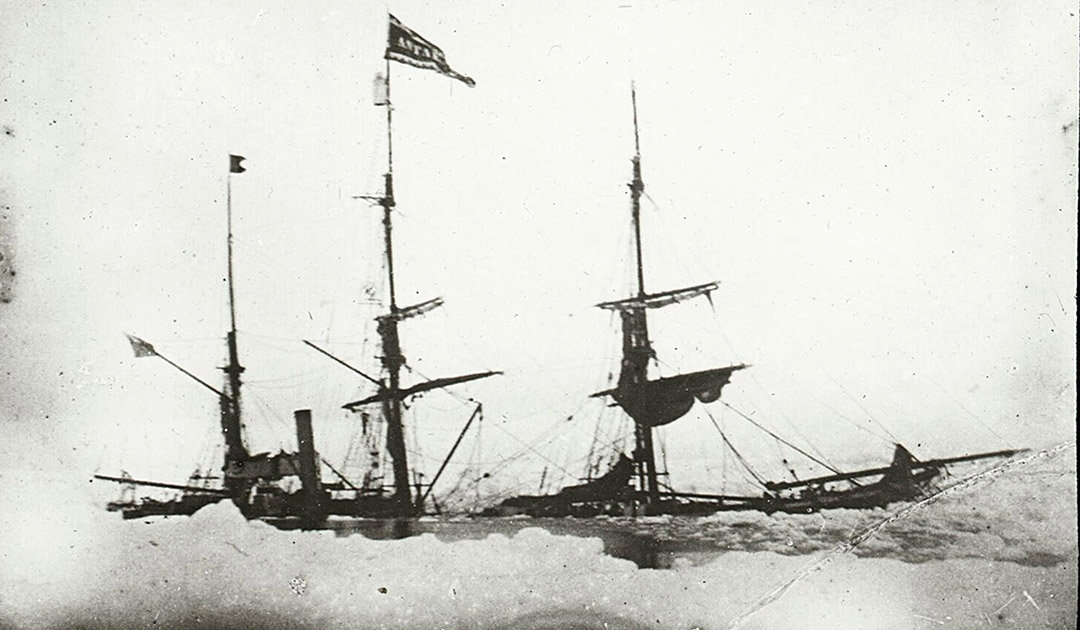
Carl Anton Larsen was born on August 7, 1860 in Østre Halsen, Norway. After attending school, he went to sea at the age of 14 and later became captain of a whaler. In 1904, he founded the village of Grytviken on South Georgia and the first Antarctic whaling company in Buenos Aires. At his instigation, a Norwegian Lutheran chapel was built in Grytviken in 1913. Larsen died on December 8, 1924 in the Ross Sea.

C.A. Larsen was more than just a Norwegian whaling captain. In 1888, the Halburg Steamship Company sent the Norwegian whaling ship “JASON” with Captain Larsen to the east coast of the Antarctic Peninsula. Although Larsen was only supposed to catch seals and whales, he did polar research on the side.
On Seymour Island, on the east coast of Graham Land, he was the first to discover fossils of plants, mollusks, and more. It was a great discovery for the science of that time. In 1893, the same shipping company sent the whaler “JASON” under Captain Larsen with two other ships to the South. On Seymour Island he collected petrified wood. He then advanced along the East coast of the Antarctic Peninsula to 68° S in the Weddell Sea. Here, he discovered a vast snow-covered highland, which he named “King Oscar II Land.” It was only in modern times that modern icebreakers made it possible to trace the journey into the WeddelI Sea.

In 1901 Larsen returned to Antarctica as captain of the “ANTARCTIC” under the command of Otto Nordenskjöld. He had to carry out the exploration and geological survey of the East coast of the Antarctic Peninsula for Nordenskjöld. Afterwards, with great difficulty, he managed to bring the Nordenskjöld expedition team to the wintering area on Snow Hill Island.
In early 1903, Larsen returned to Antarctica for the second time with the “ANTARCTIC” to pick up the Nordenskjöld expedition. The vessel got caught in increasingly dense pack ice, was pressed by the ice and began to sink. On February 12, 1903, the crew left the ship and after walking for 16 days reached Paulet Island, where the men built a stone hut and spent the winter.

Larsen and his crew reached Snow Hill Island in November 1903, the very day the Argentine gunboat “URUGUAY” anchored off the island to pick up the Nordenskjöld expedition. It was no longer expected that even a single member of the crew would have survived.
After the fortunate rescue and return to Argentina, he found Argentine financiers, and with their funds Captain Larsen founded the whaling station “Compania Argentina de Pesca” on South Georgia in 1904. The whaling station was built in a bay at the end of Cumberland Sound. Larsen named the bay “Grytvik” (Pot Bay), today’s Grytviken. In addition to establishing the whaling industry, Larsen developed the modern whaling ship, where whales were cut up on deck.

From 1923, Larsen deployed the “Sir James Clark Ross”, the first whaling factory ship, and immediately commanded the voyage himself. This was the opening of deep-sea whaling on a large scale. He made several more trips of this kind.
The whaling industry he founded in Grytviken was closed in 1962. Today, the site serves as a port of call for tourist ships and British Antarctic Survey supply and research vessels. Remains of the whaling station have been preserved until today, e.g. huge whale oil tanks, processing plants and some administrative facilities.
The Larsen Ice Shelf, located on the east coast of the Antarctic Peninsula, was named in honor of Larsen, as were the Larsen Glacier and Mount Larsen in East Antarctic Victoria Land, Mount Larsen on Morrell Island in the South Sandwich Islands archipelago.
Heiner Kubny, PolarJournal






I believe the ship was called “Antarctic”, not “Antarctica”. Antarctic Sound is named after the ship.
Thank you for your comment. You are correct, Larsen’s ship was named “Antarctic”. We apologize for this typo and will correct it immediately. Thank you for following us and our stories.
The PolarJournal Team